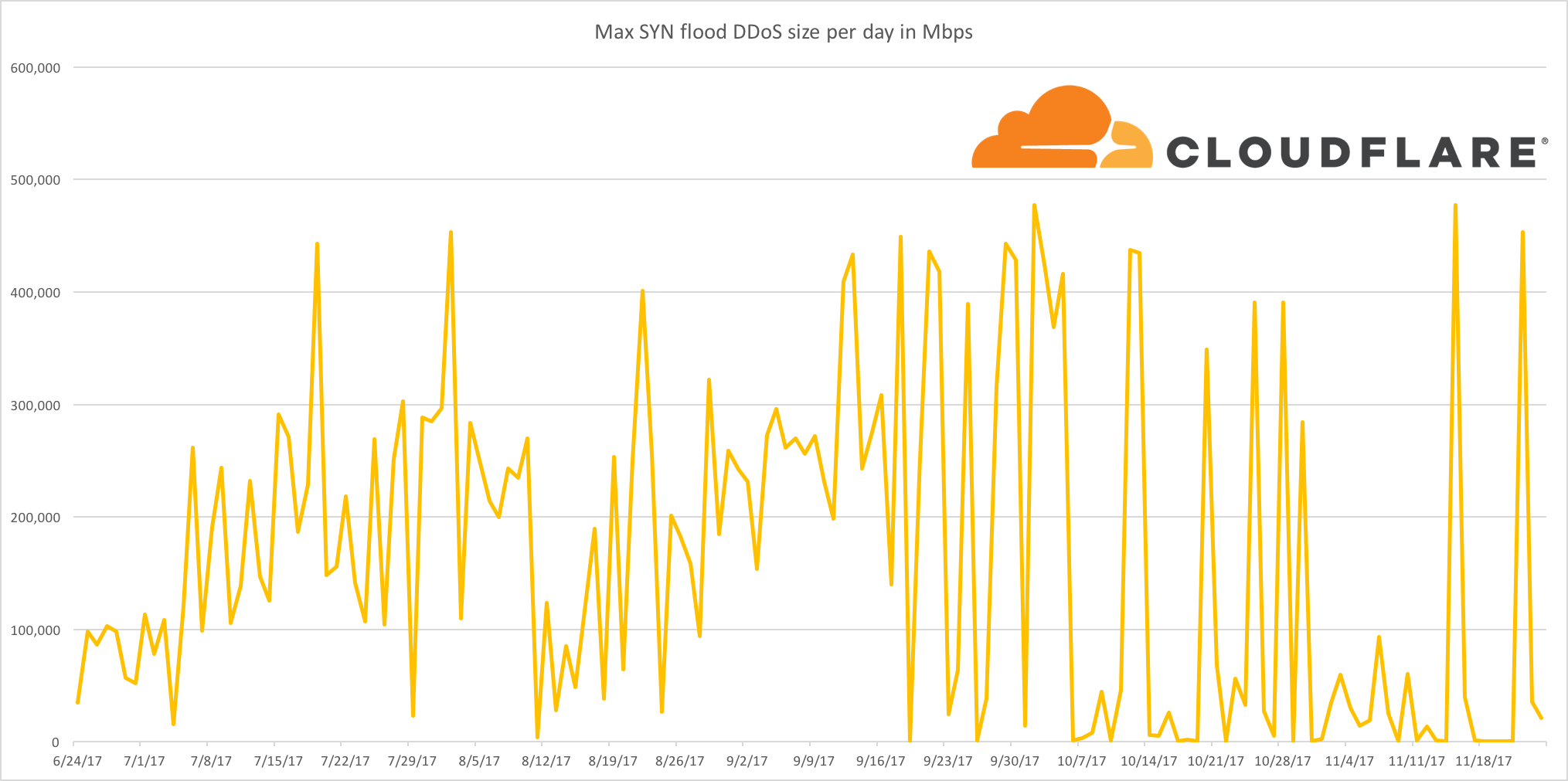2018 and the Internet: our predictions
At the end of 2016, I wrote a blog post with seven predictions for 2017. Let’s start by reviewing how I did.
 Public Domain image by Michael Sharpe
Public Domain image by Michael Sharpe
I’ll score myself with two points for being correct, one point for mostly right and zero for wrong. That’ll give me a maximum possible score of fourteen. Here goes...
2017-1: 1Tbps DDoS attacks will become the baseline for ‘massive attacks’
This turned out to be true but mostly because massive attacks went away as Layer 3 and Layer 4 DDoS mitigation services got good at filtering out high bandwidth and high packet rates. Over the year we saw many DDoS attacks in the 100s of Gbps (up to 0.5Tbps) and then in September announced Unmetered Mitigation. Almost immediately we saw attackers stop bothering to attack Cloudflare-protected sites with large DDoS.

So, I’ll be generous and give myself one point.
2017-2: The Internet will get faster yet again as protocols like QUIC become more prevalent
Well, yes and no. QUIC has become more prevalent as Google has widely deployed it in the Chrome browser and it accounts for about 7% of Internet traffic. At the same time the protocol is working its Continue reading
2018 and the Internet: our predictions
At the end of 2016, I wrote a blog post with seven predictions for 2017. Let’s start by reviewing how I did.

Public Domain image by Michael Sharpe
I’ll score myself with two points for being correct, one point for mostly right and zero for wrong. That’ll give me a maximum possible score of fourteen. Here goes...
2017-1: 1Tbps DDoS attacks will become the baseline for ‘massive attacks’
This turned out to be true but mostly because massive attacks went away as Layer 3 and Layer 4 DDoS mitigation services got good at filtering out high bandwidth and high packet rates. Over the year we saw many DDoS attacks in the 100s of Gbps (up to 0.5Tbps) and then in September announced Unmetered Mitigation. Almost immediately we saw attackers stop bothering to attack Cloudflare-protected sites with large DDoS.

So, I’ll be generous and give myself one point.
2017-2: The Internet will get faster yet again as protocols like QUIC become more prevalent
Well, yes and no. QUIC has become more prevalent as Google has widely deployed it in the Chrome browser and it accounts for about 7% of Internet traffic. At the same time the protocol is working its Continue reading
BiB 022: CloudPassage Adds Container Security To Halo Platform
CloudPassage talked with the Packet Pushers about Container Secure, a product announcement they made at AWS re:Invent earlier this year. Ethan Banks shares his impressions.
The post BiB 022: CloudPassage Adds Container Security To Halo Platform appeared first on Packet Pushers.
GDPR: Looking Beyond the Burden
All companies can learn something from the EU data protection regulation.
Wow, another Year Swooshed By…
Could you believe it? Another year swooshed by… and it’s high time to stop being snarky and cynical, disconnect from the Internet, and spend a few days with people who really matter – our families.
For me, there’s another large group of people that matter: my users.
Read more ...3GPP Approves First 5G Specification
 The 5G NR specification is a stepping stone on the path to a global 5G standard.
The 5G NR specification is a stepping stone on the path to a global 5G standard.
VXLAN designs: 3 ways to consider routing and gateway design (part 2)
In my previous post, I focused on the concepts of what is called off box routing and centralized routing. They were two different yet similar solutions. The first one being the simplest solution leveraging an external gateway to route between VXLANs. The second solution integrated the edge device to be both an external gateway and VXLAN end point (VTEP).
To expand on my previous post, the next logical place to put a gateway in VXLAN designs is to distribute them all on the top of rack (TOR), also known as the leaf. This TOR acts as a VTEP in the VXLAN solution. Its primary purpose is to encapsulate and decapsulate traffic. This solution is also colloquially known as Anycast Gateway VXLAN Routing. Anycast Gateway VXLAN Routing can only be performed on ASICs that support routing in and out of tunnels (RIOT), as discussed in the previous post. For the rest of this post, when I refer to VXLAN Routing, I specifically mean Anycast Gateway VXLAN Routing unless otherwise noted.
In the simplest form, VXLAN Routing allows the TOR to perform a route lookup on the inbound packet before encapsulating the traffic into a VXLAN tunnel. There are two ways that Continue reading
Is Container Confusion Hindering Security Advances?
 Some organizations are taking the forklift approach too literally.
Some organizations are taking the forklift approach too literally.
How Google Uses Encryption to Secure Against Cloud Data Leaks
 Google encrypts all data at rest and in transit by default.
Google encrypts all data at rest and in transit by default.
Nokia Validates xRAN by Joining Industry Consortium
 The RAN is the most expensive part of the network.
The RAN is the most expensive part of the network.
Using SDN in Multi-Layer Networks Adds Efficiency and Reliability
 Operators need reliable tools to discover, visualize, and explore multi-layer topologies and inter-connections.
Operators need reliable tools to discover, visualize, and explore multi-layer topologies and inter-connections.
Red Hat Fails to Impress Investors with Robust Q3 2018 Results
 The company sees strong container interest, though production workloads continue to lag.
The company sees strong container interest, though production workloads continue to lag.
Datanauts 115: Secure Printing With HP (Sponsored)
The Datanauts discuss securing print infrastructure with Michael Howard, Chief Security Advisor, and Jason O Keeffe, Print Security Advisor, at HP. The post Datanauts 115: Secure Printing With HP (Sponsored) appeared first on Packet Pushers.This Holiday Season, Make Sure Your Smart Toy Isn’t a Toy Soldier
In the classic holiday story The Nutcracker, toy soldiers under command of a nutcracker spring to life to fight an army of evil mice. With the growth of smart toys, armies made up of toy “soldiers” could soon become reality. Using the same features that make them “smart,” smart toys can be taken over by outside actors and forced to do their bidding.
But rather than being led by a nutcracker to fight off evil rodents, real armies of toys could be led by criminals to attack you or me.
“Smart toys” (Internet or Bluetooth-enabled toys) are some of the most popular toys this holiday season. Internet or Bluetooth functionality enables smart toys to have amazing features. There are:
- stuffed animals that play back messages sent from loved one’s smartphones
- robots that teach children how to code
- toys integrated with apps that teach reading and spelling skills while still providing physical exercise
Smart toys can do incredible things. Yet, if left unsecured, they not only present real privacy risks to the children and families who use them, but also security risks to everyone who relies on or uses the Internet.
Any Internet-connected device, be it a computer, connected thermostat, or smart toy, is at risk of being Continue reading